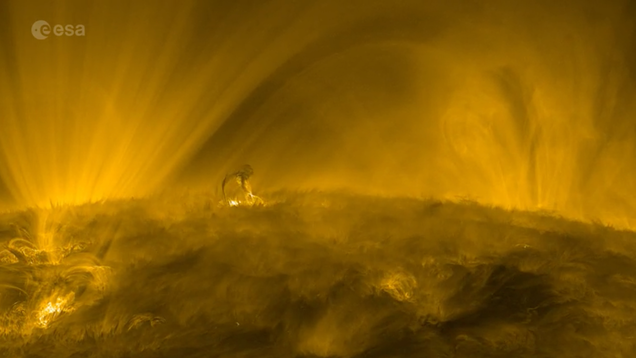The recent total solar eclipse on April 8 provided a rare glimpse of the Sun’s roiling corona, including some eye-grabbing prominences. Those views were neat, but a new video captured by Europe’s Sun-buzzing probe is providing some of the best close-up views of our host star that we’ve ever seen.
Wegovy and Ozempic: Are we ready for weight loss drugs?
This incredible video, captured on September 27, 2023, by the Extreme Ultraviolet Imager (EUI) instrument aboard the European Space Agency’s Solar Orbiter, shows the Sun from an impressive close distance, as ESA explains in a press release.
At the time of recording, the spacecraft was positioned at approximately one-third of the distance between the Earth and the Sun, or 0.33 AU. By comparison, Mercury averages around 0.39 AU from the Sun. That’s a close brush with the Sun, but Solar Orbiter is on a trajectory toward an even closer approach, set to reach a minimum distance of 43 million kilometers (0.287 AU) from the Sun on October 7.
The Sun’s corona in extreme detail
The video captures a complex and dynamic stellar environment, vividly showing the transition from the Sun’s lower atmosphere to its much hotter outer corona. Wispy, hair-like structures made of plasma, or charged gas, expose the presence of magnetic field lines bursting out from the Sun’s interior. ESA says the brightest spots seen in the video reach temperatures around one million degrees Celsius, with the dark spots being areas where radiation is absorbed.
ESA also provided an annotated version of the video to explain the various features, but here’s a breakdown. The delicate, lace-like patterns created by bright gas known as coronal “moss” can be seen in the lower left corner; these patterns are typically found around the bases of large coronal loops that are invisible under the current instrument settings. Along the solar horizon, towering spires of gas known as spicules stretch up to about 6,214 miles (10,000 kilometers) from the Sun’s chromosphere. In the center, at the 22-second mark of the video, a small eruption occurs—one that’s actually larger than Earth, showing cooler material being lifted upwards and then mostly falling back down. Coronal rain can also be seen among the erupting plasma streams.
On the same day this video was recorded, NASA’s Parker Solar Probe passed to within 4.5 million miles (7.26 million kilometers) of the solar surface, measuring particles and the magnetic field in the Sun’s corona and solar wind, according to ESA. This created a golden opportunity for collaboration, as ESA-led Solar Orbiter’s remote-sensing instruments observed the source region of the solar wind that Parker would later encounter.
So yes, the Sun is very hot right now, both literally and for stellar scientists with their intrepid solar spacecraft.
For more spaceflight in your life, follow us on X and bookmark Gizmodo’s dedicated Spaceflight page.
A version of this article originally appeared on Gizmodo.
>>> Read full article>>>
Copyright for syndicated content belongs to the linked Source : Quartz – https://qz.com/sun-picture-extreme-ultraviolet-imager-1851452322






























